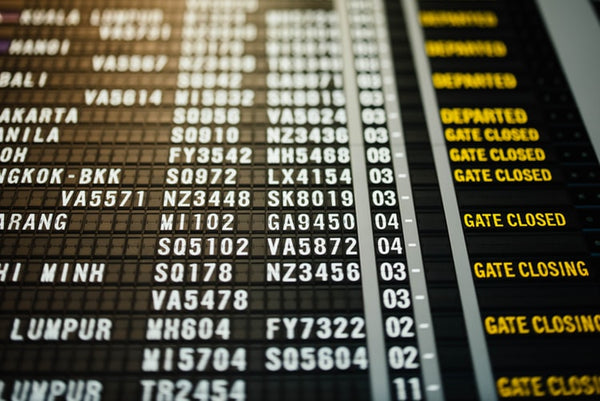
Common Wine Travel Mistakes to Avoid
Running a company designed to help people travel the world of wine, we've seen it all; the good, the bad and the ugly of wine travel. When it all comes together, there's nothing quite like it and this is the entire reason that Lazenne exists. However, it's easy to make mistakes when travelling with wine and, sometimes, with painful consequences! Here's a list of the most common travel mistakes and how to avoid them!
Lack of Planning
It might sound obvious, but it's probably the single biggest reason why wine trips go awry. Planning is really important when considering an enotourism trip, particularly in Europe. It's quite common for travellers to forget about seasonality (harvest, summer holidays etc) or to forget to call ahead and make sure that the winery is expecting their visit; most European wineries don't have tasting rooms or any sort of enotourism facilities! It's important to consider:
- How many wineries do you want to visit in a day? Fitting in more than 3 is difficult in most wine regions and we recommend trying to visit the majority in the morning, when you're fresher!
- How much do you know about the region? It really helps to have done some book studying before you go, so you can fill in the gaps rather than trying to learn everything from scratch, from the perspective of each wine-maker.
- How long will a visit take at each?
- How long is it between wineries?
- Is the wine-maker likely to be busy with harvest/bottling, or will you have their attention?
- Have you called ahead and make a booking with the winery? This is the most important of all!

Forgetting to claim the tax
Did you know that you can save quite a lot of money by recouping your VAT on wine purchases made in the EU? This is something people always forget when getting wine to bring back home with them, and it's a shame as taxes on wine are often quite high! VAT is a tax included in the price of almost all goods you buy in the EU, including wine. As you're taking your wine with you, 'exporting' it in a way, you can reclaim this amount which can be quite significant, depending on the value of the wine you've purchased.
Everytime you purchase a wine in the EU with the intention of taking it home, it's important to ask for a 'tax free form', which most retailers and wineries will be happy to provide, although it's not an obligation that they do so. Some retailers will refund you the price of the VAT in the shop, others will complete the form which you'll then claim back at the airport. Be aware that there's usually a charge associated with this service, typically a percentage of the amount you're claiming.
Assuming there's no refund in the store, take your forms to the customs officer in the airport for them to validate and stamp. They'll need to check your goods, which is why it's important to do this before checking in your luggage. The easiest way thereafter, is to take these forms to an office that deals with tax refunds within the airport, the most common of which are Global Blue and Tax Premier Free. Using these services, charges are low and refunds are often instant. Whilst this may all seem like a lot of effort, once you've done it once or twice, it becomes very simple. A piece of advice; give yourself an extra 15-20 minutes before your flight leaves at the airport, to make sure you have the time to reclaim your VAT. Then, check in your bag and make sure you catch that flight!
Not protecting your bottles
This is where we come in! One of the most common issues that people face when travelling with wine is not knowing how to do it, which usually leads to either expensive and risky shipping, or packing bottles of wines into your luggage, usually wrapped in clothes, and hoping they arrive in one piece. Shipping the wine or taking it with you these are realistically the only choices you have for getting wine from your holiday, back home with you, assuming they're wines that aren't broadly available across the world. So, why do we advocate taking it with you?
Saving money: This is a pretty simple one; shipping wine is very expensive indeed. Taking the USA as a prime example, the average cost of shipping a bottle from Italy to the US is around 15 EUR a bottle, assuming they're in a typical, 750ml format and not a trophy wine in a grotesquely heavy bottle. That's around 180 EUR to ship a case of wine from Italy to the US, which nearly always outweighs the cost of an additional piece of luggage (which may even be free with certain airlines). Certain companies will also charge broker fees on top of this, and some don't ship alcohol meaning you have to hide your wine as though it were something else; far from ideal and very risky if it's discovered.
Safe transport: This is the most important aspect of wine travel and one that's so often overlooked. Shipping companies don't typically provide boxes designed for wine travel, so it's packed into a standard cardboard box, stuffed with some sort of padding, taped up and off it goes! Assuming you bought that wine somewhere in Europe, let's say Italy, it's going to pass through a lot of different hands before it finally ends up in your destination and baggage handlers are rarely gentle. However, more dangerous than breakages is temperature fluctuations; the secret enemy of wine.
Safe delivery: Probably some of the worst horror stories we've heard from fellow wine lovers is what's waiting for them on their return from their trip. That expensive case of shipped wine, unprotected from the elements and various points of contact along the route, often doesn't even arrive! Note that in most countries it is illegal to ship alcohol. Wine shipping has become very restrictive in the United States over the last year. Many states in the USA don't allow for direct shipping at all, and should you be using a courier that doesn't allow for the shipping of alcohol, if your package is discovered the bottles will be whisked away, never to be seen again. It doesn't really bear thinking about. Beware in places like Italy, you will find vendors try to bypass the illegality of shipping alcohol by mis-declaring the package's contents (olive oil for example).

Misunderstanding Taxes and Duties
A lot of the time people travelling with wine have a fear of paying large amounts of tax at the airport, and so only bring a bottle or two with them at most, or risk the often dire airport selections. Whilst this can be true for certain countries, the reality for most is really quite different!
First and foremost, whether you're buying wine in a country or buying it back at home, the cost of duty is already included in the cost, so you're paying it one way or another. That $19,99 bottle of red wine at home? The duty is a part of that, so it's not an extra cost to pay it at the airport. Most countries have a duty-free allowance as a perk, and then duty is paid on all bottles thereafter:
The duty free allowance – This is the amount of alcohol that you're allowed to bring into a country without paying any additional fees. This can be as little as a bottle or two, all the way up to unlimited quantities and changes from country to country and even state by state in certain countries. This is not the maximum amount of wine you can bring into a country.
The overall allowance – This is the total amount of alcohol you're allowed to bring into a country as considered for 'personal use', which is defined by each country separately. This extra amount can be subject to duty fees and or taxes. We'll go through this in a little more detail in a moment.
So, you see that there's quite a big difference between the two. Unfortunately many people believe that the duty-free allowance is their total capacity and it's simply not true. It's well worth checking the rules and regulations for the country you intend to enter, but we'll explain some common scenarios below.
Declaration -It's worth noting that if you are over the duty-free allowance in any country, we always recommend that you declare yourself to customs. Failure to do so can incur spot penalties far greater than the small duty fees you would incur via declaration. It's even possible that these fees are waived as they're so low.
These are the most obvious pitfalls in wine travel but, navigate them well, and your enotourism plans are good to go! As always, where-ever the road takes you, have a wonderful time and drink some delicious wine; cheers!
For more information on how to travel with wine, check out the links below:






Laisser un commentaire
Ce site est protégé par hCaptcha, et la Politique de confidentialité et les Conditions de service de hCaptcha s’appliquent.